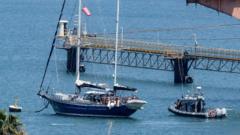President Trump's recent directive spurs contention among nations regarding seabed mineral extraction.
Trump Administration's Bold Move Towards Seabed Mining in International Waters

Trump Administration's Bold Move Towards Seabed Mining in International Waters
The new executive order challenges global norms over ocean mineral resource exploitation.
In a decisive action, President Trump has initiated a significant shift in U.S. policy toward seabed mining, gearing up for the exploration and potential extraction of vast mineral deposits located on the ocean floor. His executive order, signed recently, poses a direct challenge to international conventions that restrict such industrial activities, which are already a cause for concern among the majority of coastal nations that have ratified these treaties.
The executive order is described by the White House as an effort to bolster America’s position as a leader in the field of seabed mineral exploration. The order aims to tap into valuable resources hidden within the ocean floor, including indispensable minerals like nickel, cobalt, and manganese. These resources are crucial for advanced technologies and considered vital for U.S. economic and military interests, particularly in the face of growing control of supply chains by other nations, notably China.
Though interests in these deep seabeds, particularly in regions like the Clarion-Clipperton Zone of the Pacific Ocean, have surged among mining companies, it is worth noting that no large-scale commercial seabed mining operation has yet occurred. Technological challenges and serious environmental impacts remain pressing concerns, casting a shadow over the feasibility of such ambitious plans.
As the world watches the U.S. carve its path in this uncharted territory, the repercussions of this executive order are likely to provoke reactions from both friendly nations and adversaries alike, igniting a fierce debate around the ethics and environmental implications of seabed resource extraction.





















